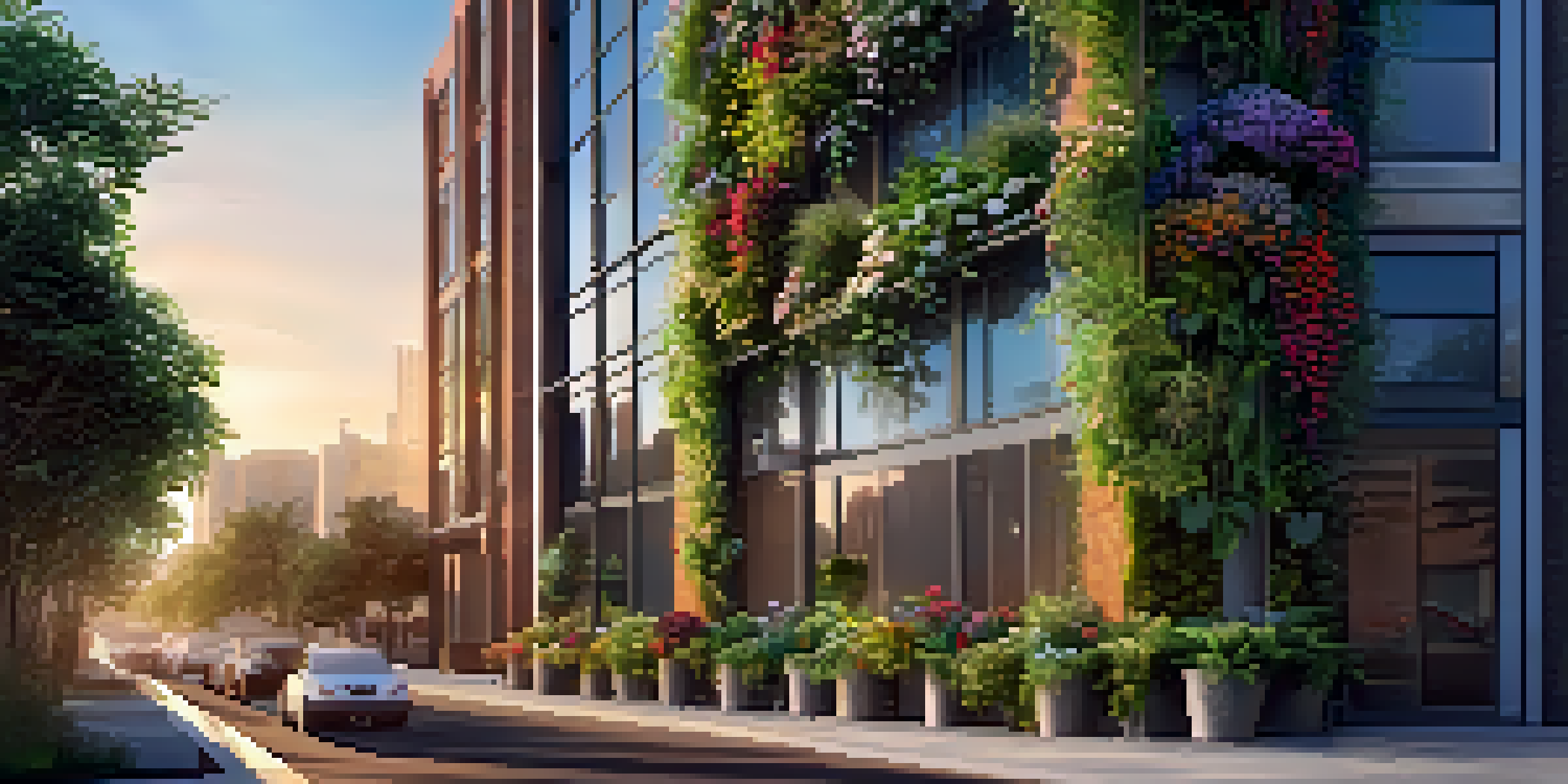Using Vertical Gardens to Combat Urban Air Pollution

What Are Vertical Gardens and Why Are They Important?
Vertical gardens, also known as living walls, are green walls featuring a variety of plants. They are not just aesthetic additions to urban landscapes; they serve a crucial role in improving air quality. By incorporating these gardens into city settings, we can create a more breathable environment, especially in densely populated areas.
The greening of cities is not just a matter of aesthetics; it is essential for the health and well-being of urban populations.
These gardens work by absorbing carbon dioxide and releasing oxygen, thus acting as natural air filters. They also capture dust, harmful pollutants, and particulate matter, which are prevalent in urban environments. Essentially, they mimic nature’s ability to cleanse the air, making them a vital tool in combating urban air pollution.
In a world where urbanization is on the rise, understanding the importance of vertical gardens becomes even more critical. They offer a unique way to integrate nature into our lives, providing health benefits while enhancing the beauty of our cities.
How Vertical Gardens Improve Air Quality
One of the most significant benefits of vertical gardens is their ability to absorb harmful pollutants. Plants take in carbon dioxide and various toxins, effectively cleaning the air we breathe. For example, studies have shown that greenery can reduce levels of nitrogen dioxide and sulfur dioxide, which are common in urban pollution.

Moreover, vertical gardens can lower ambient temperatures in cities, which is beneficial during heat waves. This cooling effect helps reduce the formation of ground-level ozone, a harmful pollutant that can exacerbate respiratory issues. By creating a cooler microclimate, these gardens not only improve air quality but also enhance overall urban livability.
Vertical Gardens Improve Air Quality
These living walls act as natural air filters by absorbing pollutants and releasing oxygen, significantly enhancing urban air quality.
Incorporating a variety of plant species in vertical gardens can maximize air purification. Different plants have unique abilities to absorb specific pollutants, so a diverse green wall can tackle multiple air quality challenges simultaneously. This diversity can play a crucial role in creating a healthier urban atmosphere.
Benefits Beyond Air Quality: Aesthetic and Psychological Gains
While improving air quality is a primary benefit, vertical gardens also enhance the visual appeal of urban spaces. A lush, green wall can transform a dull building facade into a vibrant oasis, inviting residents and visitors alike to appreciate nature amidst concrete. This aesthetic improvement can boost local property values and attract more foot traffic.
Nature is not a place to visit. It is home.
Moreover, exposure to greenery has been linked to numerous psychological benefits. Studies suggest that being around plants can reduce stress, enhance mood, and even improve cognitive function. Vertical gardens offer an easy way to introduce these mental health benefits into urban environments, creating spaces where people can relax and rejuvenate.
In essence, vertical gardens do more than just cleanse the air—they also enrich our urban experience. By making cities more visually appealing and psychologically comforting, they contribute to a higher quality of life for residents and visitors alike.
Challenges in Implementing Vertical Gardens
Despite their numerous benefits, the implementation of vertical gardens is not without challenges. One major hurdle is the initial cost of installation, which can be quite high. However, it's essential to view this as an investment in public health and urban sustainability rather than just an expense.
Maintenance is another crucial aspect that must be considered. Vertical gardens require regular care, including watering, fertilizing, and pest control. Without proper maintenance, these beautiful installations can quickly become neglected and may fail to deliver their intended benefits.
Aesthetic and Psychological Benefits
Beyond air purification, vertical gardens beautify urban spaces and provide mental health benefits by reducing stress and enhancing mood.
Additionally, selecting the right plant species for specific urban conditions is vital for the success of a vertical garden. Factors such as sunlight, climate, and air quality will influence plant growth. Therefore, careful planning and consideration are necessary to ensure these gardens thrive and continue to contribute positively to urban air quality.
Successful Examples of Vertical Gardens Worldwide
Cities around the globe are embracing vertical gardens to tackle air pollution and enhance urban living. One notable example is the Bosco Verticale in Milan, Italy, which features two residential towers adorned with over 9,000 trees. This innovative project not only beautifies the skyline but also actively contributes to improving air quality in the city.
In the United States, the High Line in New York City showcases how vertical gardens can transform urban spaces. Originally an abandoned railway, it has been turned into a lush park that incorporates various plant species, helping to filter the air while providing a green space for residents and tourists.
These examples demonstrate that vertical gardens can be successfully integrated into urban planning. By showcasing these successful projects, cities can inspire others to adopt similar strategies to combat air pollution and promote environmental sustainability.
Community Involvement in Vertical Garden Initiatives
Community involvement is crucial for the success of vertical garden projects. When local residents participate in planning and maintaining these gardens, they feel a sense of ownership and pride in their community. This engagement can lead to more sustainable practices and a greater commitment to preserving urban green spaces.
Organizing workshops and educational programs can empower communities to take an active role in vertical gardening. By teaching residents about plant care and the environmental benefits of greenery, communities can foster a culture of sustainability. This knowledge not only enhances the gardens themselves but also spreads awareness about the importance of clean air.
Community Involvement is Key
Engaging local residents in the planning and maintenance of vertical gardens fosters a sense of ownership and promotes sustainable practices.
Ultimately, community-focused vertical garden initiatives can strengthen social bonds while improving air quality. These gardens become shared spaces that encourage collaboration, creativity, and a collective effort towards a healthier urban environment.
A Call to Action: Embracing Vertical Gardens in Urban Planning
As urban air pollution continues to be a pressing issue, embracing vertical gardens in city planning becomes imperative. City officials, architects, and community leaders must collaborate to integrate these green solutions into new and existing structures. By prioritizing vertical gardens, we can create healthier and more sustainable urban environments.
Investing in vertical gardens is not just an aesthetic choice; it is a necessary step towards improving public health. The potential benefits—cleaner air, enhanced aesthetics, and improved mental well-being—far outweigh the challenges of implementation. Cities that take action now will reap the rewards for generations to come.

In conclusion, vertical gardens offer a viable solution to combat urban air pollution while enriching our urban landscapes. It’s time for cities to embrace this green revolution and cultivate a healthier, more vibrant future.